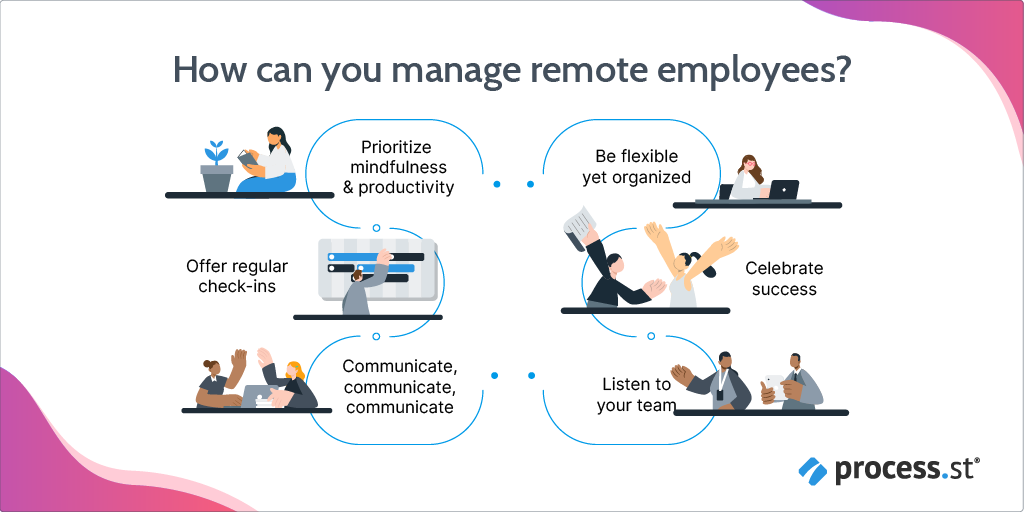
Our homes are no longer homes, and our offices are no longer offices.
The long-term impact of an abrupt shift to remote work means many employees struggle to adjust. But employees aren’t the only ones who have to adjust.
Companies now need to find a “new normal.” Remote work has given employees a taste of great flexibility and they’re not ready to part with it.
To prevent the Great Resignation, employers need to find a way to keep their business running efficiently while also promoting a healthy remote work-life balance.
We’ll explore how to adapt to this new reality. We’ll also look at how it’s impacting our recruiting, hiring, and managing of employees.
- What is a Gray Zone?
- How does remote work create the gray zone?
- The importance of balancing work and wellbeing
- Strategies for attracting, hiring, and managing remote employees
- Best practices for managing remote employees
- Adapting to a new era of work
What is a Gray Zone?
While this term can mean different things in different contexts, we’re using it to define a home working space with few to no barriers between work and everything else.
We live, work, sleep, eat, and try to relax in the same areas—the “gray zone.” Research from Craftjack found that 71% of remote workers are subjected to this gray zone and have to improvise in their working space at home.

And how do they improvise? By carving out a small corner of their home to try and dedicate to work. Research found that rooms remote workers use the most are:
- A home office: 32%
- Their bedroom: 31%
- Living room: 23%
- Kitchen: 9%
- Basement: 5%
Those of us thrown into remote work suddenly had to reorganize our homes to accommodate remote work as the shift took place. The lines between workspace and “living” space were quickly blurred, and have continued to stay blurred.
Not everyone has the luxury of a separate office space in which to work – especially folks living in urban environments – and we’ve all had to make do with what we have available, for better or worse.
Before the pandemic, only 20% of employed adults in the US worked from home. Now—that figure has jumped to a huge 71%. This increase represents a huge shift in the way we work, with 54% of employees saying they didn’t want to return to a traditional office environment.
Managers need to come to grips with recruiting and hiring a remote workforce, combined with helping their employees navigate the “new normal.”
How does remote work create the gray zone?
When it comes to home working, many of us have to improvise. Workers who are lucky enough to have a spare room have repurposed these into home offices, while others have to make do with a corner of the kitchen or lounge.
Pew Research discovered the main challenges for employees who suddenly had to transition to remote work included:
- Having the right technology or equipment
- Meeting deadlines
- Having an adequate workspace
- Being able to work without interruptions
- Feeling motivated to complete tasks
Employers must consider how to meet their employee’s needs best, whether through providing the right hardware and software or offering advice on how best to set up a home workspace where there isn’t always space for a dedicated office.
Another thing employers need to be mindful of is their staff’s mental health and well-being.
The importance of balancing work and wellbeing
When the boundaries between work and home blur, the chances of employees suffering from burnout can increase. It is tempting for employees to allow workplace responsibilities to run over into all aspects of their day-to-day lives.

Balancing working from home and well-being is vital—and many remote employees don’t necessarily understand how. Try to offer support and advice around maintaining a sense of control over the working day. Also, encourage your team to build habits that maintain motivation and productivity and boost morale.
While this will look different for every team member, it could include getting outside in nature, disconnecting from work in the gym, DIY, or anything else that helps your team feel replenished and refreshed after a long day.
While the way managers need to support their employees has changed dramatically, so have the ways those employees are recruited, hired, and managed.
Plenty of strategies are available to make this transition smoother for everyone.
Strategies for attracting, hiring, and managing remote employees
While there are challenges to successfully navigating the world of remote work—it’s also opened up many new opportunities. When attracting, hiring, and managing new remote employees, managers need to shift their strategies to make the most of this new era of work.
Attracting remote employees
One huge advantage of offering remote work to new employees is opening up a whole new pool of talent. New hires don’t have to be in your physical location. They can be anywhere in the world!
You want to look at your existing recruiting strategies to attract this new pool of talent.
For example, you may need to expand the types of places you advertise your open roles to include both global and local platforms.
Harnessing the power of social media can also help you tap into a new network of potential hires.
Hiring remote employees
If you’re not expecting your new employees to work in an office location, they probably won’t have to make the trip there for an interview either.
Many HR teams and hiring managers now use remote interview tools to assess candidates. These can be synchronous, asynchronous, or a blend of both.
Hiring tools like SaaS platforms help HR managers see candidate status, so it’s easier to check in and optimize the hiring process.
This streamlined journey can help you secure the best talent by ensuring your time to hire is as short as possible. Across all industries, the average time to hire is between three and four weeks. But the top candidates expect an offer within just five days of their interview.
If your hiring team takes too long to decide, that candidate will likely have accepted a role somewhere else by the time you get around to calling them.
Using video interview technology with integrated assessment tools or the ability to highlight key moments for the hiring team to review can drastically decrease the time it takes to make a decision.
In addition, this technology helps you run inclusive and effective interviews that focus on key skills rather than subjective opinions.
Managing remote employees

It’s time to set a start date and begin the onboarding process once the new employee accepts an offer. It’s a nervy time both for employees and employers.
Everyone’s having to adjust to bring things back to normal. Remote work can be isolating, especially for a new employee. That’s why it’s even more important to provide your new employees with support.
Following a remote employee onboarding process can help you stay on top of things and ensure your new hire knows what they need to do and when to do it.
Check out this pre-made remote onboarding template to help you get started!
Best practices for managing remote employees
Here are our tips to help you successfully manage and retain remote employees:
Prioritize mindfulness and productivity
Employees can quickly find the combination of constant distractions and never-ending notifications overwhelming.
You also may need to invest in additional benefits, tools, and software that encourage mindfulness and productivity for asynchronous workers.
These can be tailored to each employee’s work style to offer support where and when needed.
Offer regular check-ins
While making sure your employees know they can always contact you, it’s also important to emphasize—and model—the importance of a healthy work-life balance.
An example is making sure you don’t send emails outside of working hours or use a scheduling tool to send out emails at the start of the working day.
For asynchronous teams, you can add an email signature stating something like ‘while it’s convenient for me to send this email now, I do not expect a reply outside your regular working hours.’
You may decide to open slots in your calendar for a brief catch-up call with employees who would like to connect regularly.
Be flexible yet organized
Remote work can allow your employees to switch their day around and complete work during the afternoon and evening.
Allowing employees to structure their working hours can improve morale and demonstrate trust in their abilities. However, you have to stay organized to balance deadlines and keep everything running smoothly.
Communicate, communicate, communicate
Managing a team of remote employees can be a different challenge from working together in a physical office. But one of the main goals is still to maintain open lines of communication.
A great strategy is to ask each employee the management style they prefer and meet them on their terms. While some employees may resent twice-daily check-ins, others will feel cut off if they don’t hear from you regularly.
Choosing the right team communication tools and finding the balance between too much and too little communication can be a challenge, but it’s worth it.
Listen to your team
Remember that communication goes both ways—so make sure you take the time to listen to what your team thinks in addition to directing communications towards them. Informal surveys can be a good way of gauging your team’s morale.
Anonymous surveys are particularly useful as often these can encourage employees to share their thoughts more freely. Remember if you’re asking for honest feedback, you need to take action on it!
Tracking your employee net promoter score (NPS) is also a great metric to help you see if you’re on the right track in creating the kind of workplace your staff would recommend to others.
Celebrate success
It’s relatively easy to celebrate the small—and large—successes within an office environment. But it can be difficult to emulate the same informal celebrations within a remote setting.
There are plenty of options to explore, including a short celebratory video you can share on LinkedIn, your website, and other channels.
Some companies allow employees to nominate each other for a specific benefit, or you could arrange for a small parcel of treats to be delivered to an employee of the month.
Choose something that will suit your employees and their work style, and they will always appreciate it!
Adapting to a new era of work
The way we work has changed—probably forever. And for managers, that change brings with it new challenges.
With many employees struggling to define a workspace within their homes, the boundaries between work and home are blurred.
This “gray zone” can increase the risk of burnout. But there’s a huge potential for success when HR managers implement strategies around the recruitment, hiring, and managing of remote employees.
How does your company help you maintain a good remote work-life balance? Let us know in the comments.

John is a coffee-loving digital marketer who loves sharing his marketing, SEO, and entrepreneurship knowledge. When he’s not at work, he usually argues his findings and theories with his dog, Zeus.







Grace Donaldson
Grace is a content writer with a thirst for knowledge and coffee. You'll find her reading in a small café or singing at a rundown jazz bar when she's not overconsuming coffee or compartmentalizing her thoughts into a blog post.